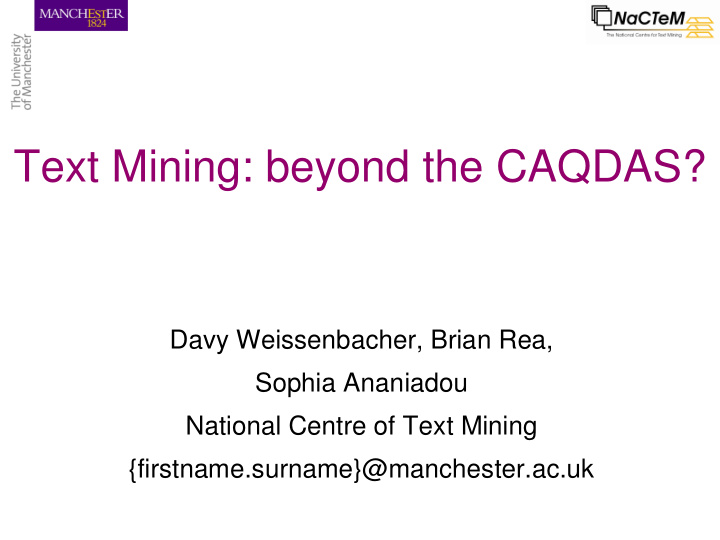



Text Mining: beyond the CAQDAS? Davy Weissenbacher, Brian Rea, Sophia Ananiadou National Centre of Text Mining {firstname.surname}@manchester.ac.uk
What a CAQDAS software do? Source document List of annotations • Adding annotations • Searching, linking and visualisation of annotations Annotation describing the sequence
What a CAQDAS software do? Reference to a • Adding annotation particular annotation • Searching, linking and visualisation of annotations Semantic label assigned to the arrow ([]: is composed of) Reference to a specific sequence in the document
What is a Text Mining (TM) Software? Word/Sentence Corpus Segmenter Automatic Annotation of Documents Named Entity Recognizer Part Of Speech Tagger Syntactic Analysis Term Tagger Lemmatizer Information Retrieval Annotated Automatic Corpus Summary .. .
Are the CAQDAS and TM software competitors? • CAQDAS and TM software are designed to add annotations but: • CAQDAS: human annotation (Hundreds of documents) TM : automatic annotation (Millions of documents) ● CAQDAS: Semantic and Pragmatic annotations TM : Syntactic and Simple semantic annotations
How can TM techniques complement CAQDAS software? • TM techniques enrich CAQDAS: • QDA Miner + Wordstat: stoplist for word frequency, lemmatizer, thesaurus for retrieving sequence to annotate, clustering of documents ● Qualrus: machine learning techniques to propose sequences to annotate • TM techniques are used to: • Extend the user queries • Focus the user attention on the pertinent sequences ➔ The ASSIST Project: evaluate the benefits of TM for frame analysis of Media
ASSIST project • Aims to deliver a service for searching and qualitatively analysing social science documents • NaCTeM is designing and evaluating an innovative search engine embedding text mining components ● Domain knowledge facilitates expansion of user queries ● Real Time clustering of search results ● Term extraction for improved browsing capabilities ● Semantic Information enrichment for targeting the main topics • Final deliverable will include a web demonstrator for further integration into JISC e-Infrastructure • NaCTeM local project website: http://www.nactem.ac.uk/assist/
Technical Characteristics Multi-format TM components documents •Named Entity Recognizer BaLIE Conversion tools •Term Extractor .PDF with pdfbox Termine Search Engine .DOC with POI •Anaphora resolver Lucene .HTML with Jtidy Bayaphora .XML •Lexical Chain extractor User Search result clustering Query Web Query Interface Lingo Indexed Documents
Query interface Expanding the standard query interface Semantic operators to build complex queries Browsing documents through a domain taxonomy Improving the rank of query results • Resolution of Pronominal Anaphora relations to compute the real frequency of search words ( e.g. The dog eats the cat. It sleeps now)
Search Result Interface Clustering the query results in real time Lingo algorithm merges instances of commonly occurring phrases, keeping the best candidate to describe each cluster A familiar presentation of query results including snippets
Search Result Interface Document content is described using semantic information ✔ makes document analysis easier, faster and more efficient
Access to document contents Document content is described using semantic information Metadata: informing the origin of documents Terms: most significant multi-words phrases in the document Named Entities: main discourse objects belonging to predefined categories Lexical chains: gathering terms to build up concept representations
Query Results Visualization Examination of cluster memberships via a friendly visualisation interface Graphical representation of the intersection between the clusters provides immediate visualization of cluster relations ✔ Information regarding membership of particular cluster
Document Analysis Identification of conceptually similar documents using the most commonly occurring terms and words in the source document Highlighting selected semantic information within the document ✔ Selecting terms according to their importance and using them to browse documents
Conclusion • Both applications designed for annotating documents but TM software complements the CAQDAS software • TM techniques help the fastidious annotation stage of the qualitative analysis • Presentation of the ASSIST project for evaluating the benefits of a tool based on TM for frame analysis of Media
Recommend
More recommend